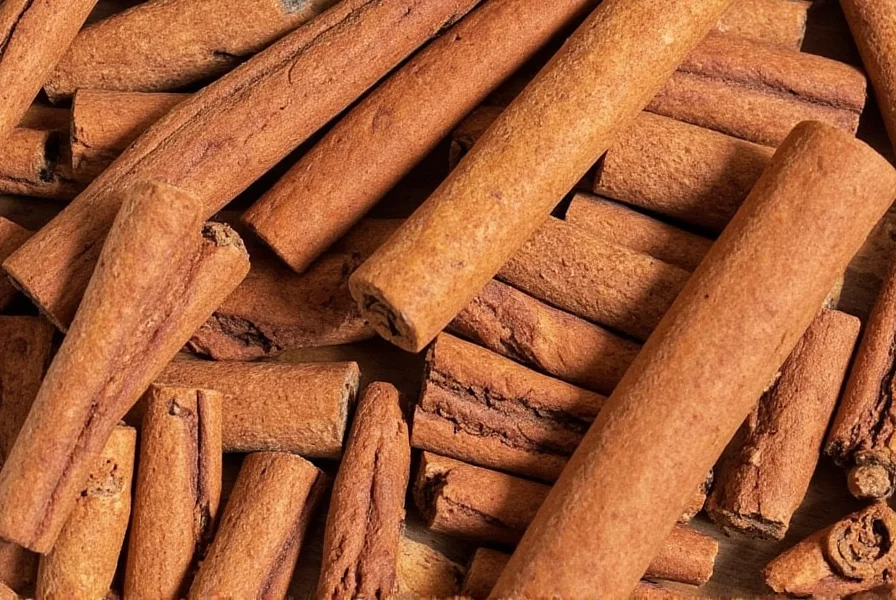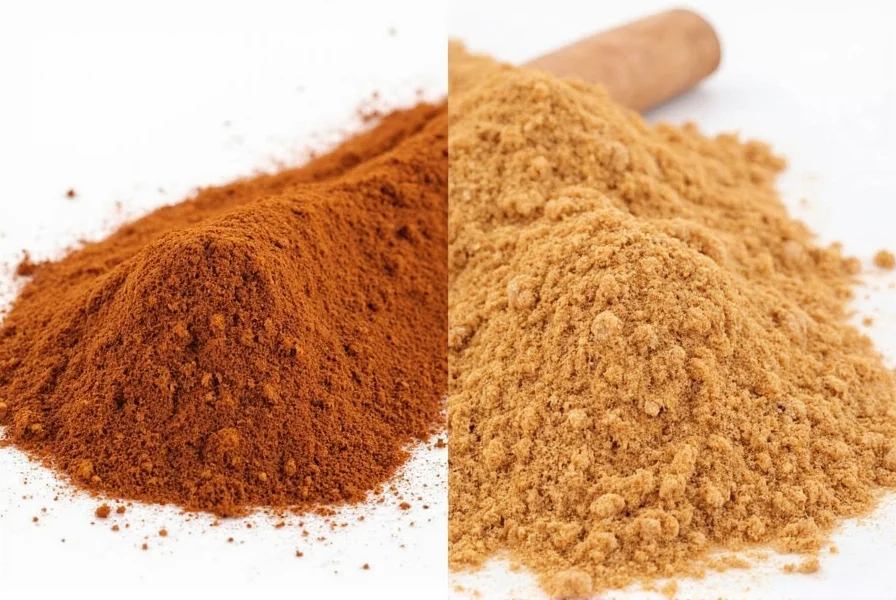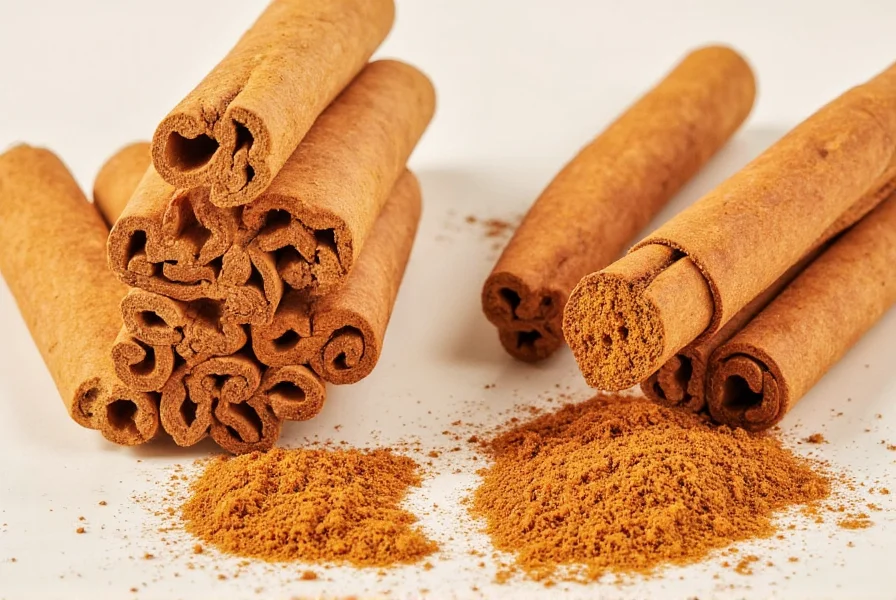| Feature | Cassia Cinnamon | Ceylon Cinnamon |
|---|---|---|
| Origin | Indonesia, China, Vietnam | Sri Lanka (formerly Ceylon) |
| Flavor Profile | Strong, spicy, slightly bitter | Delicate, floral, citrusy |
| Appearance | Thick, coarse single-ply quills | Thin, multi-layered quills |
| Coumarin Content | High | Low |
| Price | Affordable | Expensive |
| Common Uses | Baking, mulled drinks, savory dishes | Desserts, beverages, medicinal applications |
Introduction
When comparing Cassia and Ceylon cinnamon, understanding the key differences is crucial for both health and culinary applications. This guide provides accurate, science-backed information to help you make informed choices about which cinnamon type suits your needs.


Both cinnamon varieties offer distinct characteristics that impact their flavor, safety, and best uses in cooking. Whether you're a home cook, health-conscious consumer, or culinary professional, knowing the differences between Cassia and Ceylon cinnamon can significantly improve your kitchen results and health outcomes.
What is Cassia Cinnamon?
Cassia cinnamon (Cinnamomum cassia) is the most commonly available type in supermarkets, primarily sourced from Indonesia, China, and Vietnam. It's characterized by its thick, rough bark and strong, spicy flavor profile.
Key Characteristics:
- Bold, pungent flavor with a slightly bitter edge
- Thicker, coarser bark that's difficult to grind
- High coumarin content (1-13 mg/g)
- More affordable and widely available
- Commonly used in baked goods and savory dishes where strong flavor is desired
What is Ceylon Cinnamon?
Ceylon cinnamon (Cinnamomum verum), often called "true cinnamon," originates from Sri Lanka. It's recognized by its delicate, multi-layered structure and subtle, complex flavor profile.
Key Characteristics:
- Milder, sweeter, and more nuanced flavor with floral and citrus notes
- Thin, delicate bark that easily crumbles
- Extremely low coumarin content (under 0.017 mg/g)
- Higher cost due to limited supply and labor-intensive harvesting
- Favored in gourmet cooking and health-focused applications
Health Implications: Which One is Healthier?
Scientific research shows that coumarin content is the most significant health factor when choosing between cinnamon types. The European Food Safety Authority (EFSA) recommends a maximum daily coumarin intake of 0.1 mg per kg of body weight.
For a 150-pound (68 kg) adult, this equals approximately 6.8 mg of coumarin per day. A single teaspoon of Cassia cinnamon contains about 5-12 mg of coumarin, while the same amount of Ceylon contains less than 0.017 mg.
Health Recommendations:
- Ceylon: Safe for daily consumption in any quantity. Recommended for children, pregnant women, and those with liver conditions.
- Cassia: Limit to ½ teaspoon (1-2 grams) per day for adults. Avoid regular consumption if you have liver issues.
Both types provide antioxidants and anti-inflammatory benefits, but Ceylon's safety profile makes it the superior choice for consistent use.
Cooking with Cassia vs Ceylon
The flavor differences significantly impact how each cinnamon performs in various culinary applications:
For Baking
- Cassia: Ideal for chocolate desserts, gingerbread, and spice cakes where bold flavor is desired. Use 1:1 ratio.
- Ceylon: Better for delicate pastries, custards, and fruit-based desserts where subtle flavor is preferred. Use 1.5x more than Cassia for equivalent flavor intensity.
For Savory Dishes
- Cassia: Excellent in Indian curries, Middle Eastern rice dishes, and Mexican mole sauces.
- Ceylon: Best for mild sauces, meat rubs, and Moroccan tagines where delicate flavor won't overpower.
For Beverages
- Cassia: Perfect for robust drinks like spiced coffee, mulled wine, and chai tea.
- Ceylon: Ideal for lattes, herbal teas, and golden milk where subtle cinnamon flavor is preferred.
Buying Guide: How to Choose Between Cassia and Ceylon
When shopping for cinnamon, look for these distinguishing features:
Identifying Cassia
- Hard, thick sticks that don't crumble easily
- Rough outer surface with deep grooves
- Dark reddish-brown color
- Labeled simply as "cinnamon" or "Chinese cinnamon"
Identifying Ceylon
- Soft, brittle sticks that crumble easily when bent
- Light tan to pale brown color
- Finely layered appearance resembling rolled paper
- Labeled as "Ceylon cinnamon" or "True Cinnamon"

Cassia Ground Cinnamon – Organic & Fair Trade
Features: Pure Indonesian Cassia powder, sustainably sourced, rich flavor.
Advantages: Affordable, great for everyday use.
Use Cases: Baking, oatmeal, coffee blends.
Target Audience: Home bakers, casual cooks.
Best For: Budget-friendly pantry staple.
Ceylon Cinnamon Sticks – Premium Quality
Features: Authentic Sri Lankan origin, low coumarin, hand-harvested.
Advantages: Safe for regular use, premium taste.
Use Cases: Tea infusions, slow-cooked desserts, gift-worthy presentation.
Target Audience: Gourmet chefs, health-conscious consumers.
Best For: High-end recipes and wellness routines.
Final Verdict
For most people, Ceylon cinnamon is the superior choice due to its safety profile and nuanced flavor. While Cassia offers strong flavor at a lower price, its high coumarin content makes it less suitable for regular consumption.
Recommendation:
- Use Ceylon cinnamon for daily consumption, especially in beverages and desserts
- Use Cassia cinnamon occasionally for specific recipes where strong flavor is desired
- Always check labels carefully - "cinnamon" alone typically means Cassia
By understanding these differences, you can make informed choices that improve both your cooking results and long-term health outcomes.
Frequently Asked Questions (FAQ)
What is the main difference between Cassia and Ceylon cinnamon?
The primary differences involve origin, appearance, flavor, and coumarin content. Cassia comes from Indonesia/China/Vietnam with thick, dark single-layer quills and a bold, spicy taste. Ceylon originates from Sri Lanka, featuring thin, multi-layered quills with a lighter color and delicate floral-citrus flavor. Crucially, Cassia contains high coumarin levels (1-13 mg/g) while Ceylon has minimal amounts (under 0.017 mg/g), making it significantly safer for regular consumption.
Which cinnamon is healthier for daily use?
Ceylon is significantly healthier for regular consumption due to its extremely low coumarin content. The European Food Safety Authority recommends a maximum coumarin intake of 0.1 mg per kg of body weight. For a 150-pound person, this equals about 6.8 mg of coumarin - reached with just 1 teaspoon of Cassia powder. Ceylon has no such restrictions, making it safe for unlimited culinary use without health risks.
Can I substitute Cassia for Ceylon in recipes?
Yes, but with important adjustments. Use ⅔ less Cassia than Ceylon due to its stronger flavor. Cassia works well in robust dishes like chocolate desserts or beef curries, but will overpower delicate recipes like poached pears or custards where Ceylon shines. Never substitute 1:1 in medicinal doses - Ceylon's low coumarin is essential for therapeutic applications.
How much Cassia cinnamon is safe to consume daily?
Limited to ½ teaspoon (1-2 grams) per day for adults. The European Food Safety Authority sets a maximum coumarin intake of 0.1 mg per kg of body weight. For a 150-pound person, this equals about 6.8 mg of coumarin - reached with just 1 teaspoon of Cassia powder. Ceylon has no such restrictions, making it safe for unlimited culinary use.
Why is Ceylon cinnamon called "true cinnamon"?
Ceylon earned the "true cinnamon" title because it's the original variety documented in ancient texts (like Egyptian papyri and Roman records) and traded along historic spice routes. The name "cinnamon" technically refers only to Ceylon (Cinnamomum verum), while Cassia is a botanical cousin (Cinnamomum cassia). Modern labeling often misuses "cinnamon" for Cassia due to its market dominance.
How can I verify if my cinnamon is authentic Ceylon?
Check three features: 1) Quills should be thin, soft, and layered (like rolled paper) that crumble when bent, 2) Color should be light tan—not dark reddish-brown, 3) Label must explicitly say "Ceylon" or "True Cinnamon." Avoid products labeled only as "cinnamon," which are almost always Cassia. For powder, authentic Ceylon has a pale beige hue versus Cassia's rusty red.










 浙公网安备
33010002000092号
浙公网安备
33010002000092号 浙B2-20120091-4
浙B2-20120091-4